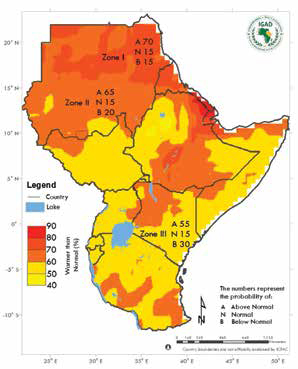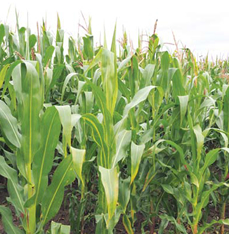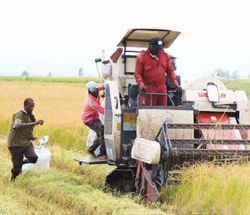Best Management Practices
Use these tools to assess the risk of developing herbicide-resistant weeds and to manage fields with resistant weed populations. By bringing diverse crop management techniques to their farms, growers can mitigate the development and spread of herbicide-resistant weeds.
Weed populations typically have a wide range of genetic variability. A small number of plants in any weed populations may include genetic traits that are resistant to specific herbicides. When a herbicide is applied, most of the susceptible plants are controlled, but resistant plants continue to grow. If allowed to set seed, these resistant weeds could grow and set seed the next year if the same herbicide was used.
Read more ...
Climate Outlook for the March to May 2023 Rainfall Season
 March to May (MAM) constitutes an important rainfall season, particularly in the equatorial parts of the Greater Horn of Africa (GHA), where MAM rainfall contributes up to 60% of the total annual rainfall. Analysis of global climate model predictions from 7 Global Producing Centres (GPCs) customized for the GHA indicates that drier than normal conditions are most likely to continue over the drought affected regions of Ethiopia, Kenya, and Somalia. Enhanced probability for below normal rainfall is also expected over parts of Uganda, Rwanda, Burundi, Tanzania, and western South Sudan. On the other hand, wetter than normal conditions are expected over the cross-border areas of Ethiopia and South Sudan, north-western Kenya, and parts of central and southern Tanzania. In other parts of the region, including parts of central to western Kenya, north-eastern and southwestern Uganda, northern Burundi, central and northern Tanzania, and eastern South Sudan, there is no favoured rainfall category with predictions indicating equal chances of below, normal, and above normal rainfall.
March to May (MAM) constitutes an important rainfall season, particularly in the equatorial parts of the Greater Horn of Africa (GHA), where MAM rainfall contributes up to 60% of the total annual rainfall. Analysis of global climate model predictions from 7 Global Producing Centres (GPCs) customized for the GHA indicates that drier than normal conditions are most likely to continue over the drought affected regions of Ethiopia, Kenya, and Somalia. Enhanced probability for below normal rainfall is also expected over parts of Uganda, Rwanda, Burundi, Tanzania, and western South Sudan. On the other hand, wetter than normal conditions are expected over the cross-border areas of Ethiopia and South Sudan, north-western Kenya, and parts of central and southern Tanzania. In other parts of the region, including parts of central to western Kenya, north-eastern and southwestern Uganda, northern Burundi, central and northern Tanzania, and eastern South Sudan, there is no favoured rainfall category with predictions indicating equal chances of below, normal, and above normal rainfall.
Read more ...
 If you are going to plant maize, then it stands to reason that you intend to get the best yield possible off the plants growing in that field. This means you will have carefully considered all your seed, fertilisation and weed control requirements. One of the most important factors to consider is plant nutrition. It is important to use the right fertiliser to ensure the plant roots can take up all the nutrients available in the soil and convert this into grain. It is therefore necessary to take regular soil samples, so you know how much fertiliser to apply. There is still more to the science of fertilisation though, because it is equally important to apply the necessary nutrients at the right time, so the plant can use it as efficiently as possible.
If you are going to plant maize, then it stands to reason that you intend to get the best yield possible off the plants growing in that field. This means you will have carefully considered all your seed, fertilisation and weed control requirements. One of the most important factors to consider is plant nutrition. It is important to use the right fertiliser to ensure the plant roots can take up all the nutrients available in the soil and convert this into grain. It is therefore necessary to take regular soil samples, so you know how much fertiliser to apply. There is still more to the science of fertilisation though, because it is equally important to apply the necessary nutrients at the right time, so the plant can use it as efficiently as possible. March to May (MAM) constitutes an important rainfall season, particularly in the equatorial parts of the Greater Horn of Africa (GHA), where MAM rainfall contributes up to 60% of the total annual rainfall. Analysis of global climate model predictions from 7 Global Producing Centres (GPCs) customized for the GHA indicates that drier than normal conditions are most likely to continue over the drought affected regions of Ethiopia, Kenya, and Somalia. Enhanced probability for below normal rainfall is also expected over parts of Uganda, Rwanda, Burundi, Tanzania, and western South Sudan. On the other hand, wetter than normal conditions are expected over the cross-border areas of Ethiopia and South Sudan, north-western Kenya, and parts of central and southern Tanzania. In other parts of the region, including parts of central to western Kenya, north-eastern and southwestern Uganda, northern Burundi, central and northern Tanzania, and eastern South Sudan, there is no favoured rainfall category with predictions indicating equal chances of below, normal, and above normal rainfall.
March to May (MAM) constitutes an important rainfall season, particularly in the equatorial parts of the Greater Horn of Africa (GHA), where MAM rainfall contributes up to 60% of the total annual rainfall. Analysis of global climate model predictions from 7 Global Producing Centres (GPCs) customized for the GHA indicates that drier than normal conditions are most likely to continue over the drought affected regions of Ethiopia, Kenya, and Somalia. Enhanced probability for below normal rainfall is also expected over parts of Uganda, Rwanda, Burundi, Tanzania, and western South Sudan. On the other hand, wetter than normal conditions are expected over the cross-border areas of Ethiopia and South Sudan, north-western Kenya, and parts of central and southern Tanzania. In other parts of the region, including parts of central to western Kenya, north-eastern and southwestern Uganda, northern Burundi, central and northern Tanzania, and eastern South Sudan, there is no favoured rainfall category with predictions indicating equal chances of below, normal, and above normal rainfall. Rice is currently the third important staple crop after maize and wheat in Kenya. It can be considered as an alternative cereal to supplement maize as it is preferred by households in ASAL regions (WB 2011).
Rice is currently the third important staple crop after maize and wheat in Kenya. It can be considered as an alternative cereal to supplement maize as it is preferred by households in ASAL regions (WB 2011). What’s known about changing weather patterns in Kenya?
What’s known about changing weather patterns in Kenya?